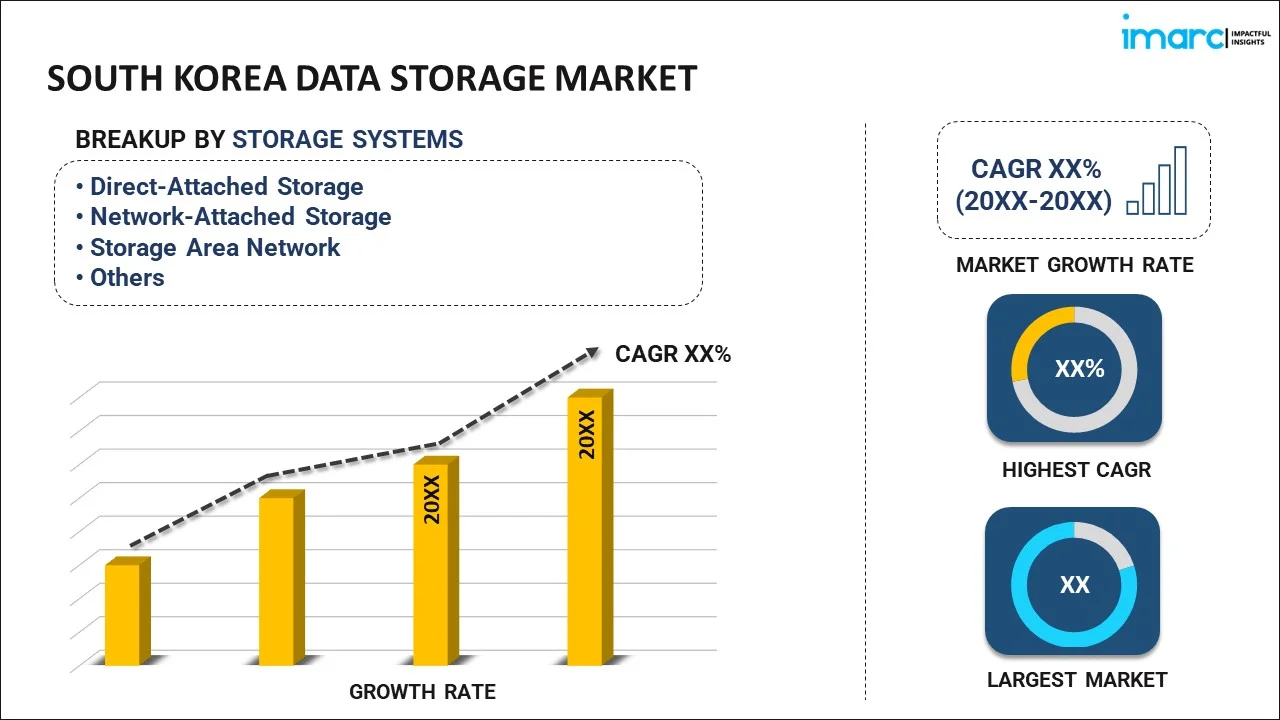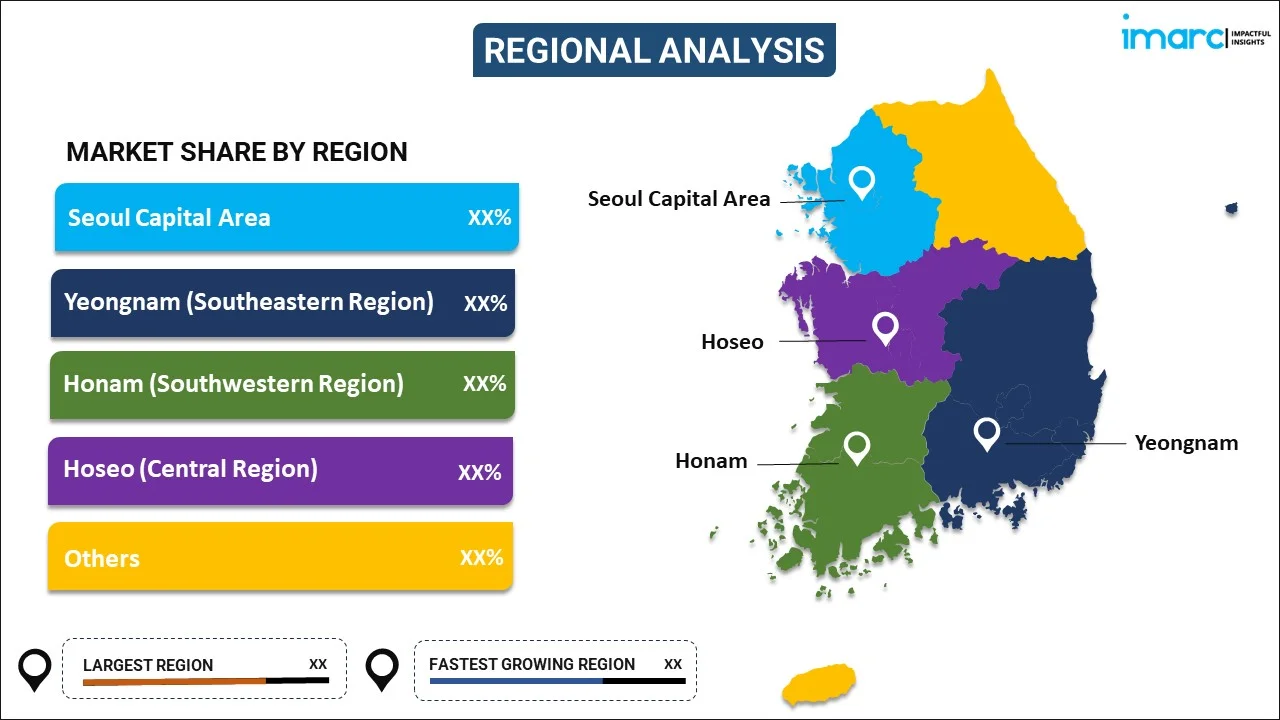
South Korea Data Storage Market Report by Storage System (Direct-Attached Storage, Network-Attached Storage, Storage Area Network, Cloud Storage, Software Defined Storage), Storage Architecture (File and Object Based Storage, Block Storage), End User (Media and Entertainment, Education, IT and Telecommunications, Defense and Aerospace, Banking, Financial Services, and Insurance (BFSI), Consumers, and Others), and Region 2025-2033
Market Overview:
South Korea data storage market size reached USD 5.9 Billion in 2024. Looking forward, IMARC Group expects the market to reach USD 22.2 Billion by 2033, exhibiting a growth rate (CAGR) of 14.2% during 2025-2033. The increasing data generation across various industrial verticals, rising fifth-generation (5G) adoption, advancements in artificial intelligence (AI) and machine learning (ML), a robust electronics industry, favorable government initiatives, the escalating awareness about cybersecurity, the thriving e-commerce industry, and the shift to remote work represent some of the key factors driving the market.
|
Report Attribute
|
Key Statistics
|
|---|---|
|
Base Year
|
2024 |
|
Forecast Years
|
2025-2033
|
|
Historical Years
|
2019-2024
|
| Market Size in 2024 | USD 5.9 Billion |
| Market Forecast in 2033 | USD 22.2 Billion |
| Market Growth Rate (2025-2033) | 14.2% |
Data storage refers to the systematic process of storing, managing, and preserving digital information in a structured and accessible manner. In computing, data is the fundamental component of applications, systems, and organizations, encompassing a vast array of information such as documents, images, videos, databases, and more. Data storage provides a reliable and efficient means of retaining this information for future use. Various storage technologies exist to accommodate different needs, ranging from traditional hard disk drives (HDDs) to modern solid-state drives (SSDs), cloud storage solutions, and emerging technologies like holographic storage. The efficiency of data storage is crucial for ensuring quick and secure access to information, as well as for safeguarding against data loss or corruption. Moreover, data storage plays a pivotal role in supporting critical functions such as data analysis, business operations, and research activities. It offers scalability, speed, and reliability, driving innovations in both hardware and software solutions to address the dynamic nature of information management in the digital age.
South Korea Data Storage Market Trends:
The surge in data generation across various sectors, including finance, healthcare, manufacturing, and telecommunications, has fueled the demand for robust storage solutions, primarily driving the market growth. In line with this, with the rapid digitalization of businesses across the country, there is a heightened need for scalable and efficient storage infrastructure, creating a positive outlook for market expansion. Moreover, the rising proliferation of smartphones, Internet of Things (IoT) devices, and social media platforms has contributed significantly to the burgeoning data volumes, thus strengthening the market growth. In confluence with this, South Korea's proactive approach to fifth-generation (5G) adoption into diverse applications, from smart cities to autonomous vehicles, necessitates advanced storage capacities, as high-speed connectivity facilitates seamless data transfer and enhances user experiences, thereby aiding in market expansion. Concurrently, the emphasis on AI and ML technologies in South Korea, leading to a surge in data-intensive workloads, has spurred the need for sophisticated storage solutions capable of handling vast datasets and ensuring rapid data access, creating a positive outlook for market growth. In addition to this, the country's robust electronics and semiconductor sector, featuring global industry giants, fostering a tech-savvy environment that encourages the adoption of cutting-edge storage technologies, is presenting lucrative opportunities for the market expansion. Furthermore, the continued miniaturization of electronic devices and the proliferation of connected devices catalyzing innovations in storage solutions to meet the evolving needs of consumers are providing an impetus to the market growth. Apart from this, South Korea's government's supportive policies and investments in smart cities, digital healthcare, and other digital initiatives have propelled the demand for storage infrastructure to support these initiatives, propelling the market forward.
South Korea Data Storage Market Segmentation:
IMARC Group provides an analysis of the key trends in each segment of the market, along with forecasts at the country level for 2025-2033. Our report has categorized the market based on storage system, storage architecture, and end user.
Storage System Insights:

- Direct-Attached Storage
- Network-Attached Storage
- Storage Area Network
- Cloud Storage
- Software Defined Storage
The report has provided a detailed breakup and analysis of the market based on the storage system. This includes direct-attached storage, network-attached storage, storage area network, cloud storage, and software defined storage.
Storage Architecture Insights:
- File and Object Based Storage
- Block Storage
A detailed breakup and analysis of the market based on the storage architecture have also been provided in the report. This includes file and object based storage and block storage.
End User Insights:
- Media and Entertainment
- Education
- IT and Telecommunications
- Defense and Aerospace
- Banking, Financial Services, and Insurance (BFSI)
- Consumers
- Others
The report has provided a detailed breakup and analysis of the market based on the end user. This includes media and entertainment, education, IT and telecommunications, defense and aerospace, banking, financial services, and insurance (BFSI), consumers, and others.
Regional Insights:

- Seoul Capital Area
- Yeongam (Southeastern Region)
- Honam (Southwestern Region)
- Hoseo (Central Region)
- Others
The report has also provided a comprehensive analysis of all the major regional markets, which include Seoul Capital Area, Yeongam (Southeastern Region), Honam (Southwestern Region), Hoseo (Central Region), and Others.
Competitive Landscape:
The market research report has also provided a comprehensive analysis of the competitive landscape in the market. Competitive analysis such as market structure, key player positioning, top winning strategies, competitive dashboard, and company evaluation quadrant has been covered in the report. Also, detailed profiles of all major companies have been provided.
South Korea Data Storage Market Report Coverage:
| Report Features | Details |
|---|---|
| Base Year of the Analysis | 2024 |
| Historical Period | 2019-2024 |
| Forecast Period | 2025-2033 |
| Units | Billion USD |
| Scope of the Report | Exploration of Historical and Forecast Trends, Industry Catalysts and Challenges, Segment-Wise Historical and Predictive Market Assessment:
|
| Storage Systems Covered | Direct-Attached Storage, Network-Attached Storage, Storage Area Network, Cloud Storage, Software Defined Storage |
| Storage Architectures Covered | File and Object Based Storage, Block Storage |
| End Users Covered | Media and Entertainment, Education, IT and Telecommunications, Defense and Aerospace, Banking, Financial Services, and Insurance (BFSI), Consumers, Others |
| Regions Covered | Seoul Capital Area, Yeongnam (Southeastern Region), Honam (Southwestern Region), Hoseo (Central Region), Others |
| Customization Scope | 10% Free Customization |
| Post-Sale Analyst Support | 10-12 Weeks |
| Delivery Format | PDF and Excel through Email (We can also provide the editable version of the report in PPT/Word format on special request) |
Key Questions Answered in This Report:
- How has the South Korea data storage market performed so far and how will it perform in the coming years?
- What has been the impact of COVID-19 on the South Korea data storage market?
- What is the breakup of the South Korea data storage market on the basis of storage system?
- What is the breakup of the South Korea data storage market on the basis of storage architecture?
- What is the breakup of the South Korea data storage market on the basis of end user?
- What are the various stages in the value chain of the South Korea data storage market?
- What are the key driving factors and challenges in the South Korea data storage?
- What is the structure of the South Korea data storage market and who are the key players?
- What is the degree of competition in the South Korea data storage market?
Key Benefits for Stakeholders:
- IMARC’s industry report offers a comprehensive quantitative analysis of various market segments, historical and current market trends, market forecasts, and dynamics of the South Korea data storage market from 2019-2033.
- The research report provides the latest information on the market drivers, challenges, and opportunities in the South Korea data storage market.
- Porter's five forces analysis assist stakeholders in assessing the impact of new entrants, competitive rivalry, supplier power, buyer power, and the threat of substitution. It helps stakeholders to analyze the level of competition within the South Korea data storage industry and its attractiveness.
- Competitive landscape allows stakeholders to understand their competitive environment and provides an insight into the current positions of key players in the market.
Need more help?
- Speak to our experienced analysts for insights on the current market scenarios.
- Include additional segments and countries to customize the report as per your requirement.
- Gain an unparalleled competitive advantage in your domain by understanding how to utilize the report and positively impacting your operations and revenue.
- For further assistance, please connect with our analysts.
 Request Customization
Request Customization
 Speak to an Analyst
Speak to an Analyst
 Request Brochure
Request Brochure
 Inquire Before Buying
Inquire Before Buying




.webp)




.webp)












